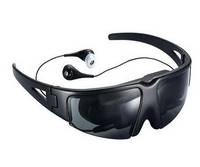

#Itheater eyewear tv
Here’s a quick diagram that breaks this down:īasically, all of the video and audio signals are sent to the TV from a media device, or it even originates from the TV via a built-in smart app. Essentially it works by sending audio in the reverse direction to a connected soundbar or A/V receiver. HDMI ARC and eARC can be a little confusing for someone to understand at first. Of course, if you are watching something on Netflix that doesn’t have Dolby Atmos audio, then you won’t get Dolby Atmos. If you are using a direct HDMI connection from a media device (Fire TV, Apple TV, Nvidia Shield TV, etc.) to a Dolby Atmos soundbar or A/V receiver, then you’ll definitely get Dolby Atmos audio if it is available. I’ll do my best to break it down below: HDMI It may seem simple at first, but it’s slightly complicated. There is a pretty big difference between using HDMI, HDMI ARC, and HDMI eARC for audio transmission. If you want to transmit a Dolby Atmos signal, you’ll need to use HDMI, HDMI ARC, or HDMI eARC. However, there are certain things you have to keep in mind before proceeding to set up this connection.
#Itheater eyewear plus
These include the Dolby Digital Plus audio codec for lossy or compressed Dolby Atmos or the Dolby TrueHD audio codec for lossless or uncompressed Dolby Atmos. Unfortunately, the ones that support Dolby Atmos can’t be transmitted via digital optical. In addition, DTS Digital surround’s codec is designed by a completely different company than Dolby.

Unfortunately, both of these codecs do not support Dolby Atmos.ĭolby Digital was designed long before Dolby Atmos was introduced the first time. In addition, the 5.1 channels of audio support are either via the Dolby Digital or the DTS Digital Surround audio codecs.
#Itheater eyewear code
As a matter of fact, the optical cable can process either 2 channels of uncompressed pulse code modulation (PCM) audio or up to 5.1 channels of compressed audio. Digital Optical Lacks Support for Height Channelsĭigital optical cables don’t support the bandwidths needed to transmit high-definition sound effects. Now that we’re clear about the naming situation, let’s find out about the limitations that restrict digital optical cables from supporting Dolby Atmos. However, there are a few types of S/PDIF cables other than TOSLINK that can support coaxial cables along with digital optical. This is because optical cables make use of the TOSLINK connection system, developed by Toshiba.įurthermore, S/PDIF, which stands for Sony/Philips Digital Interface, relies on a technology similar to that of TOSLINK. You can find the TOSLINK label on many optical cables. Options like the KabelDirekt 10 feet Optical/TOSLINK cable (on Amazon) will typically use all those terms in the product listing to cut down on confusion. With many names used to describe digital optical, many feel confused when they hear “TOSLINK” and “S/PDIF.” However, these names are interchangeable. And, because it uses light to transmit sound, you can actually see light coming from the end of the cable. Unlike HDMI and other recently developed cables, digital optical is not made of copper. Why Digital Optical Doesn’t Support Dolby Atmosĭigital optical was introduced in the 1980s to connect CD players with audio receivers. So, with no further delay, let’s read on to find out why digital optical cables do not support this particular audio format and how you can still use Dolby Atmos to bring more depth to your streaming and gaming experience.

This news might seem disappointing however, there are ways you can transmit Digital Atmos signal over your audio devices. HDMI is the only method to send/receive signals with Dolby Atmos. Digital optical cables only support up to 5.1 channels of audio. However, there’s one important question that needs to be addressed: Can the classic digital optical cable support Dolby Atmos signals?ĭigital optical doesn’t support Dolby Atmos because it can’t transmit the Dolby Digital Plus or Dolby TrueHD audio codecs (both of which can contain Dolby Atmos audio).

Today, there are many streaming platforms, soundbars, TVs, and devices that support Dolby Atmos surround sound technology, and it is truly exciting to indulge in the immersive sound experience that the format offers.


 0 kommentar(er)
0 kommentar(er)
